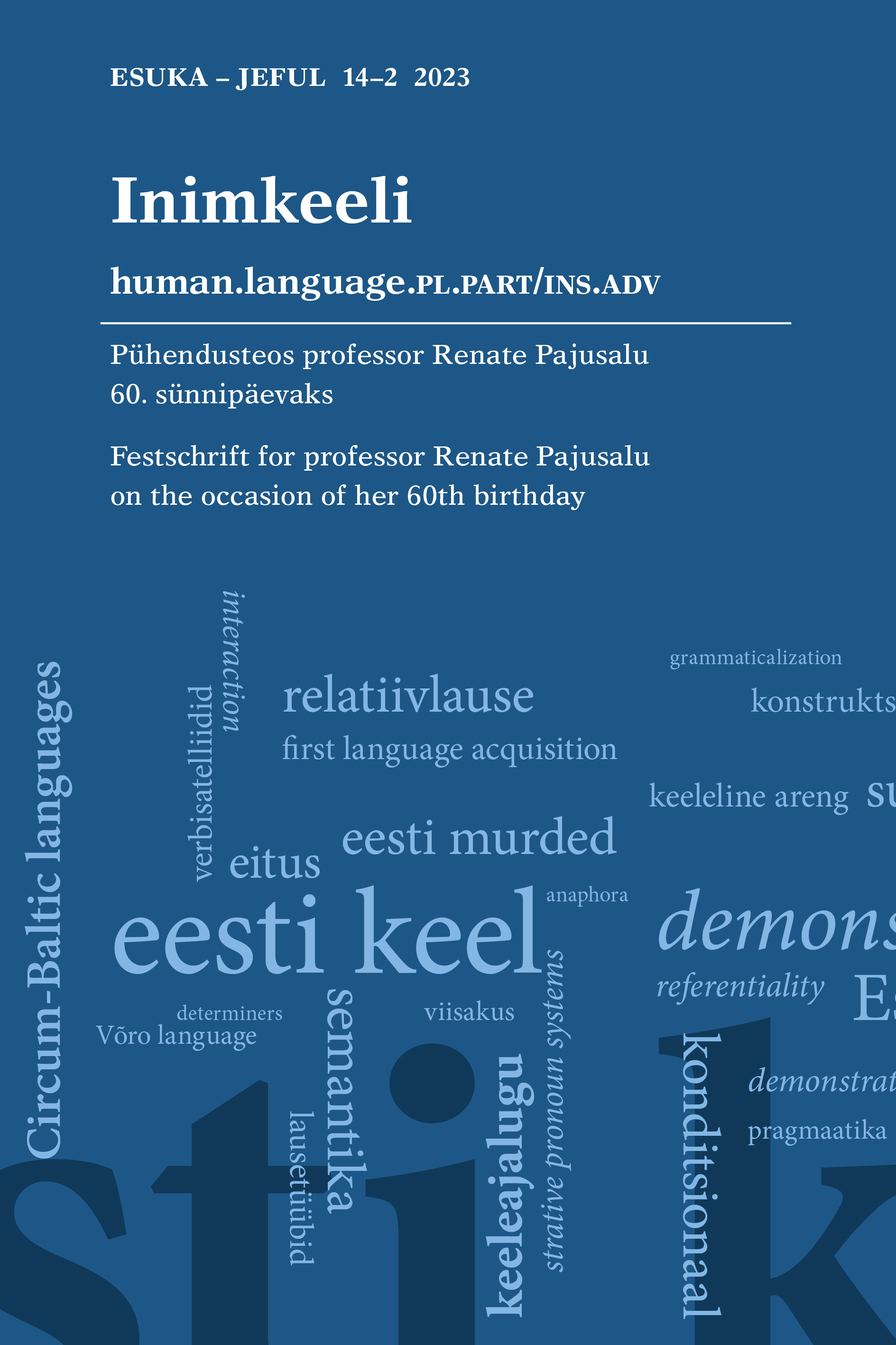<i>Mina tahan, aga sina vaata</i>. Eri tähendusega verbide ja isikuliste asesõnade omandamisest eesti keeles
DOI:
https://doi.org/10.12697/jeful.2023.14.2.05Keywords:
isikukategooria, omandamine, personaalpronoomenid, verbi tähendusrühmad, pöördevormid, meeleteooria, eesti keele omandamine, acquisition of person category, personal pronouns, semantic verb classes, verb inflection forms, Theory of Mind, acquisition of EstonianAbstract
Artiklis antakse ühe lapse spontaanse kõne andmestiku põhjal ülevaade isikukategooria, st nii personaalpronoomenite kui ka nendega koos esinevate verbide omandamisest eesti keeles. Vaadeldakse, mille poolest erinevad esimese isiku tegevusi väljendavad verbid teise ja kolmanda isiku omadest ja kuivõrd sobitub eesti lapse spontaanse kõne andmestik (lapse vanusest 1;4–3;0, kokku 20 tundi) Wellmanni ja Liu (2004. Scaling of theory-of-mind tasks. Child Development 75(2). 523–541) meeleteooria intensiivsusastmestikule vastavate verbide omandamisjärjekorraga. Uurimuse keskmes on kõik lapse finiitverbi konstruktsioonid, nende jagunemine isikuti ning verbi tähendustüübiti, vähemal määral pronoomenid, mis neis konstruktsioonides esinevad. Kõige rohkem esines lapse kõnes ainsuse kolmanda isiku finiitverbi konstruktsioone, mõnevõrra vähem esimese ja hoopis vähem teise isiku konstruktsioone. Finiitverbi konstruktsioonid omandab laps eri tähendusi väljendavate verbide põhjal esimeses ja teises isikus erinevalt: kõigepealt hakkab laps rääkima enda soovidest ja tegevusest ning kõige viimasena arvamusest, teise isiku puhul kasutab laps alguses kognitiivseid protsesse tähistavaid, seejärel tegevust märkivaid verbe. Teise isiku konstruktsioonides esinevate verbide omandamisjärjekord kattub suures osas Wellmanni ja Liu (2004) esitatud meeleseisundite komplekssuse skaalaga.
Abstract. Reili Argus. I want but you look. The acquisition of different verb classes and personal pronouns in Estonian. The article gives an overview of the acquisition of the person category, i.e. both personal pronouns and verbs occurring with them, in Estonian on the basis of spontaneous speech data (20 hours in total) of an Estonian child (age 1;4–3;0). The main goal of the study is to examine how first-person constructions differ from second- and third-person constructions concerning the semantics of a verb. All verbs in 1SG and 2SG are divided into semantic classes (actions, states, desires/ wishes, beliefs, knowledge, emotions, sensory perception) using the division based partly on Wellmann’s and Liu’s (2004. Scaling of theory-of-mind tasks. Child Development 75(2). 523–541) scale of complexity of mental states. Third person constructions form the biggest part in the child’s speech, the amount of first person constructions is smaller in some extent and second person constructions were used with lesser frequency. The child acquires different verbs in different person constructions: first the child starts to talk about his own desires and actions, the verbs for knowing and emotions emerge late. In the second person constructions, the child first uses verbs denoting cognitive processes, then emerge verbs for actions. The order of acquisition of verbs in second-person constructions largely coincides with the scale of increasing complexity of mental states provided by Wellmann and Liu (2004).
Downloads
Downloads
Published
How to Cite
License
Copyright (c) 2023 Reili Argus

This work is licensed under a Creative Commons Attribution 4.0 International License.


